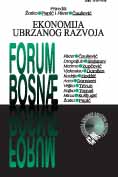Intraindustrijska trgovina – od komparativnih ka konkurentskim prednostima u vanjskoj trgovini Bosne i Hercegovine
Intra-Industrial Trade – From Comparative Towards Competitive Advantages in Foreign Trade of Bosnia and Herzegovina
Author(s): Anto DomazetSubject(s): Economy
Published by: Međunarodni forum Bosna
Keywords: intra-industrial trade; comparative advantages; competitiveness
Summary/Abstract: Liberalization of foreign trade and regional integration, on the one hand, and restructuring of production and adaptation to the demand on the markets of the actual CEFTA and EU, on the other, contributed to dynamic growth of foreign trade of Bosnia and Herzegovina during the period 2002-2007. Dominant mode of Bosnia and Herzegovina’s foreign trade in year 2002 was inter-industrial exchange, based on comparative advantages. At the end of the observed period this becomes intra-industrial trade. This way the rule is affirmed that in the initial phase of economic development of a country foreign trade is dominantly based on comparative advantages, and that with further development the factors of competitiveness contributing to the development of intra-industrial trade get their significance. Dominancy of intra-industrial trade is displayed in trade within actual CEFTA and EU because of adequate adaptation of Bosnia and Herzegovina’s offer for export to these markets and because of a deeper integration of production from Bosnia and Herzegovina into the chains of values of production in these groupings. In trading with other countries, inter-industrial exchange remains dominant mode of trade. In the sector structure intra-industrial exchange dominates in industries with greater degree of fragmentation, technological content, and possibility for diversification of production. Future development of intra-industrial trade of Bosnia and Herzegovina will be defined by the dynamics of transitional and reform changes on the path of integration into the EU and by the tempo of restructuring and modernization of production for needs of demands in CEFTA and EU in the phase of development lead by efficiency with investments as initiators of growth of competitiveness.
Journal: Forum Bosnae
- Issue Year: 2008
- Issue No: 43
- Page Range: 134-165
- Page Count: 33
- Language: Bosnian
- Content File-PDF

